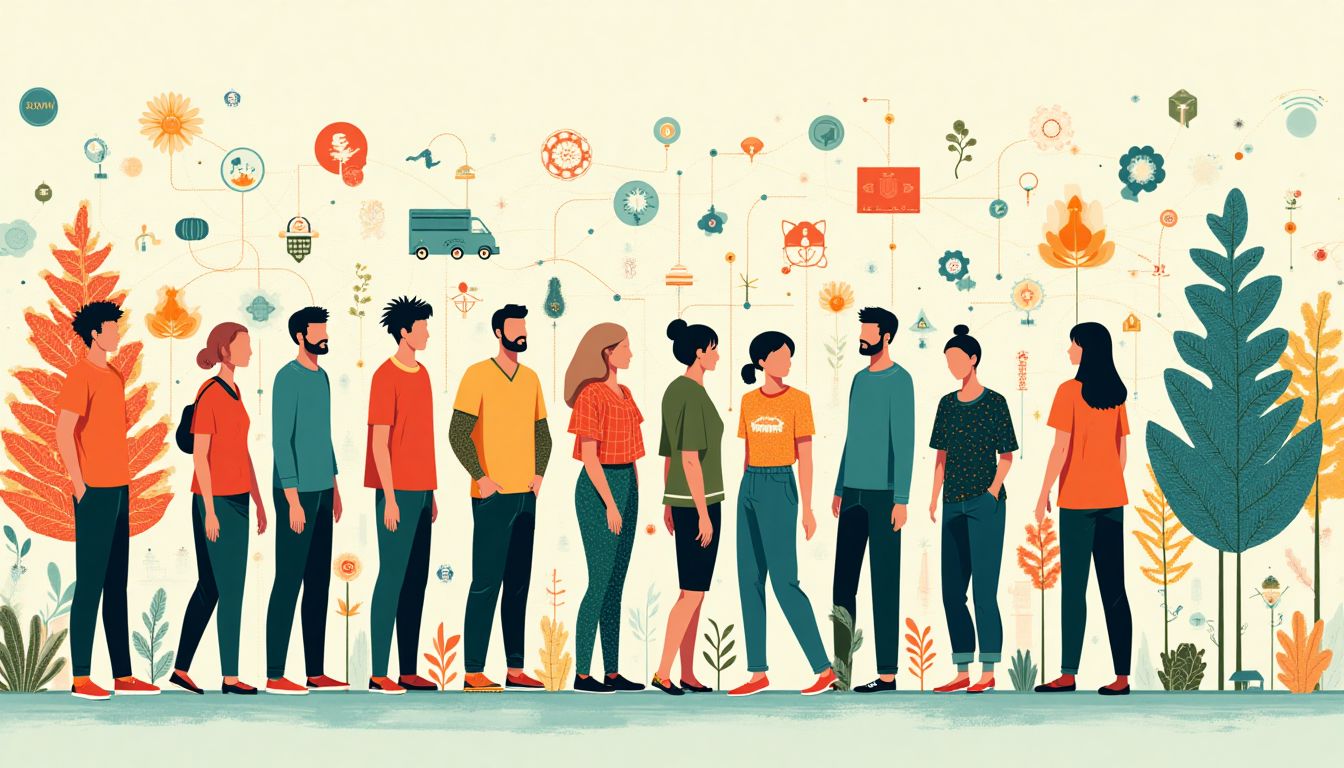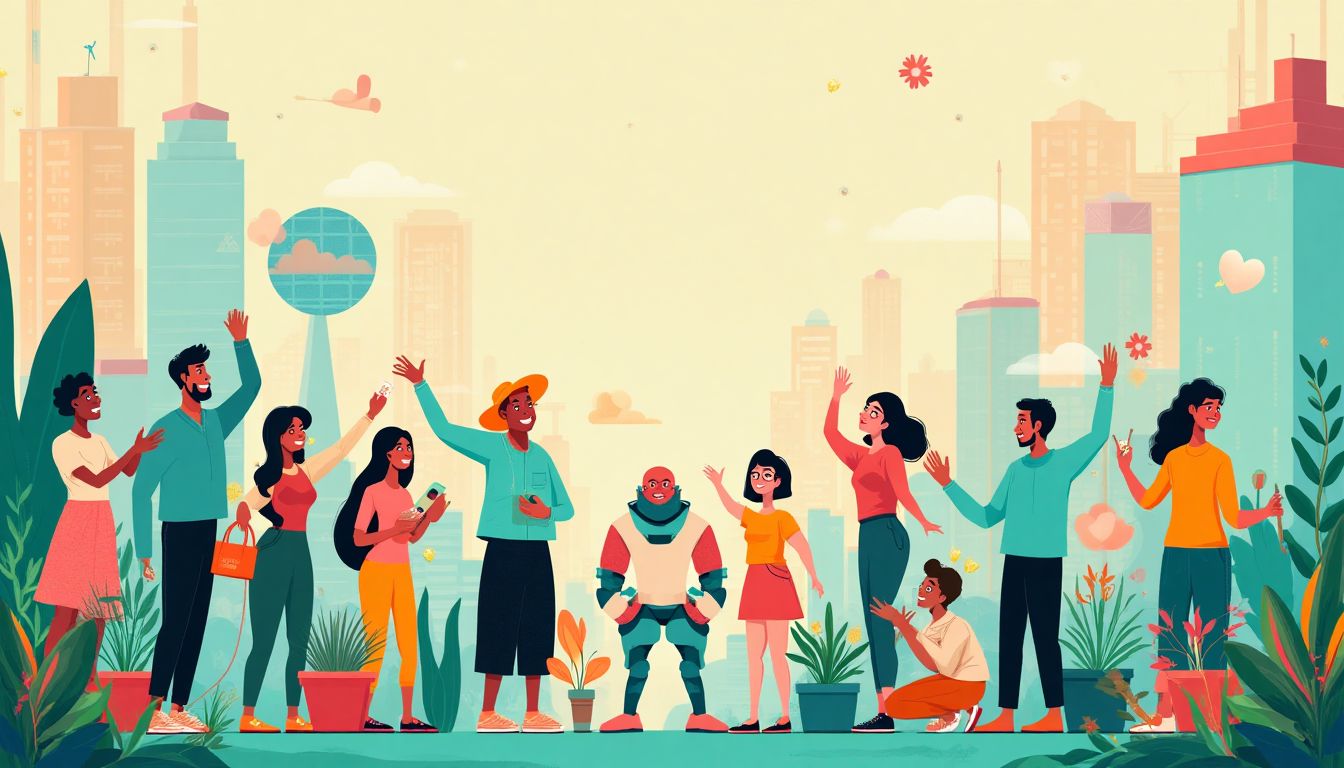Introduction
The best way to find yourself is to lose yourself in the service of others. – Mahatma Gandhi once expressed this enlightening thought. In a world where technology and humanity often seem at odds, there's a whisper of harmony hidden in these words, a dance of potential that beckons us forward. Imagine a society where Artificial General Intelligence (AGI) unleashes a river of compassion, washing away the mundane tasks of survival work and leaving us free to build communities brimming with hope and optimism.
How does a computer help us find our human side? As technology advances at light speed, it's essential to ask: will AGI merely refine the way we live, or could it redefine what it means to be human? This isn't just any old tech evolution; we're talking about a transformation that could rival anything from a classic Isaac Asimov novel, as seen in his musings in "I, Robot." The future of AGI offers us a choice: let the technology control us, or seize the opportunity to control how technology helps us reconnect to our humanity. Elon Musk has pondered AGI's potential, Stephen Hawking envisaged its risks, and Yuval Noah Harari explored its implications—all captivating our imaginations about what's possible when we're freed from the mundane and inspired to volunteer and uplift our neighbors.
Understanding AGI and Its Implications
Cue the techie fanfare! Let's journey into the realm of Artificial General Intelligence (AGI) to unravel what it actually is and why it's the hot topic of today. First, AGI stands in stark contrast to narrow AI, like Apple's Siri or Amazon's Alexa, which excel at very specific tasks like telling jokes or ordering groceries. AGI, on the other hand, can potentially tackle anything—it's like the ultimate multitasker, one minute solving mathematical equations, the next playing the saxophone, all while advising Stephen Hawking-level theoretical insights!
Imagine if AGI could liberate us from what we lovingly (or not) call "survival work." Ever heard someone grumble about their job of shuffling and reshuffling spreadsheets day in and day out? Yeah, neither have we. But AGI might be the key to making that repetitive cycle a thing of the past. Imagine, waking up not just to earn a paycheck, but to lend a hand in community gardens or build houses for those in need. It sounds dreamlike, doesn’t it?
Think about past tech shifts—a little trip down historical lane—to see what happens when technology changes the work game. In the 19th century, the Industrial Revolution gave rise to urban working classes, but it also resulted in urban volunteer movements motivated to address the new challenges these shifts brought. What if AGI takes us to the next stage, where technology not only supports our work but inspires us to invest in our communities?
Certain renowned futurists like Ray Kurzweil speculate that AGI might one day surpass human intelligence, leading us to a new era of possibilities. AGI is not just about giving computers a smarter brain but also about providing humanity the time and bandwidth to enrich society by volunteering. This vision isn't about futuristic robots running amok, but instead about humans forging a better, more cohesive community. We're on the edge of a thrilling possibility where the untapped wellspring of human compassion can be set free, thanks in part to our AI friends lending a helping circuit!
The Rise of the Volunteer Economy
Let's picture this for a moment: a world where our day planners are dotted not with meetings marked by anxiety, but with volunteering adventures marked by purpose. Imagine swapping out time spent on the nine-to-five grind with activities that truly fuel our passions. Thanks to AGI, this isn’t just a fantasy. Welcome to the burgeoning era of the volunteer economy.
Economic Shifts
Now, before you get too comfortable dreaming of leisurely philanthropic endeavors, let's talk economics. We know money talks louder than a kindergarten class left without supervision. The shift towards a volunteer-driven economy would redefine traditional job markets. With AGI taking the wheel on mundane tasks, we’re looking at an economy where people engage in activities driven by choice rather than necessity. Imagine a community where volunteering is just as valued as a 'real job' (and perhaps even offers the same bragging rights as winning the fantasy football league).
Examples from the Past
History offers glimpses of volunteer movements that shaped societies. Let's take a trip down memory lane, shall we? During World War II, nations across the globe witnessed unprecedented levels of volunteerism. From victory gardens to war bonds, communities came together with a common cause. Fast forward to the 1960s, and we see the rise of the social justice movement, powered in part by volunteer efforts. These examples underscore the potential impact of large-scale volunteerism. They reveal how, just like a captivating Netflix series, a collective movement can sweep nations off their feet and drive societal change. Who knew that a little bit of free time could go such a long way?
Fostering Community Connections
Think back to the last time you liked a photo of a cute dog on social media. What if fostering community connection was as easy as double-tapping your screen? AGI promises to make community engagement as effortless as a Sunday stroll, but with way more impact.
Building Relationships
Volunteering isn’t just about ticking off a good deed from the list—it’s an incredible way to forge strong community bonds. Imagine unlocking the neighborly potential hidden within your community, turning handshakes with strangers into high-fives with friends. AGI, with its omnipresent eye and learning capabilities, can match you up with like-minded volunteers and projects that resonate with your values. Using AGI is like having a matchmaker for friendships and projects, minus the awkward first dates.
Addressing Local Issues
Communities, much like your grandma’s favorite quilt, are made up of unique and varied pieces. Volunteerism can be the thread that weaves them all together. Volunteering opens the door to addressing significant local issues like poverty, education, and health once ignored under the shadow of more pressing survival tasks. By engaging individuals in meaningful community work, volunteering could be the equivalent of giving your neighborhood the TLC it sorely needed—like Marie Kondo for societal issues. Let's spark joy the AGI way and empower communities one volunteer at a time.
Education and Empowerment
In our quest for a world enriched by volunteerism, education and empowerment emerge as essential pillars. Imagine a society where knowledge isn't just about grades but an awakening force for change. Educational institutions like Harvard University and Stanford University hold the power to mold minds towards community service with purpose and passion. This transformation is akin to turning a simple whisper into a resonating voice for change.
Lifelong Learning
Education isn't a sprint; it's a marathon, a lifelong journey where every step is an opportunity for growth. Schools, colleges, and learning platforms can integrate volunteerism into their curriculum. Imagine starting each day with a lesson in compassion and ending with actions that reflect those teachings. A study conducted by the Proceedings of the National Academy of Sciences found that linking education with service, known as service-learning, significantly boosts social responsibility. Isn't that a powerful idea? Empower our youth and watch them ignite the future.
Training and Development
Beyond formal education, training platforms like Coursera and Udacity offer tailored skill development for those eager to serve. Training builds bridges between intention and action, turning enthusiasm into expertise. Could learning modules on leadership, community building, or empathy sharpen volunteer engagement? Data from Skillsoft's 2021 Workforce Survey shows that 57% of employees believe skill development can enhance community involvement. The ripple effect? Trained individuals ready to transform communities from the grassroots up.
Overcoming Challenges and Resistance
In ever-evolving technological landscapes, resistance to change can cast a shadow over progress. Yet, history has shown that with every challenge, an opportunity for transformation arises. The mysteries of AGI and its potential to redefine volunteerism may sow seeds of skepticism. But, fear not! The path to understanding lies in addressing concerns head-on, with tact and transparency.
Addressing Skepticism
Skeptics often equate AGI with a future bereft of humanity and jobs. Yet, the truth diverges. Consider AGI as an ally, not a foe. It could handle mundane tasks, freeing us for meaningful work. It's akin to having a teammate who covers the routine, so you focus on creativity. Pew Research reveals that informed individuals are 30% more positive about AI's societal impact. Therefore, education about AGI isn't merely important; it's imperative.
Easing Economic Fears
The specter of unemployment looms large over any economic transition. However, history shows that adaptation isn't just survival, it's evolution. Jobs morph, people reskill, and economies thrive. The transition to a volunteer-oriented society is no different. Imagine an economy where AI takes on routine work, and people pursue passions—a creative renaissance! Organizations like World Economic Forum predict AI could create more jobs than it displaces by 2025. It's about embracing new roles, not merely replacing old ones.
AI Solutions: How Would AI Tackle This Issue?
As we embark on this journey towards a volunteer-centric society, Artificial Intelligence (AI) emerges as a powerful ally in facilitating community engagement and enhancing volunteerism. The potential of AI is vast, and by leveraging algorithmic systems, we can streamline how volunteers are connected with community needs.
One of the most promising applications of AI lies in the development of smart matching systems. These systems could utilize machine learning algorithms to understand individual preferences, skills, and interests. This way, volunteers can be effectively matched with projects and causes they are passionate about. Imagine a retired teacher sharing their expertise in local schools or a software engineer developing apps for non-profits. By finding the right task for the right person, we would maximize not just participation but also the impact of volunteer efforts.
Another crucial application is predictive analytics. AI can process big data to identify community needs before they become apparent. For instance, if a region shows a rise in homelessness or food insecurity, AI can help predict these trends and suggest preemptive measures, allowing organizations to mobilize resources proactively. This could lead to a powerful feedback loop where community needs are continuously addressed through volunteer efforts, creating a culture of giving that circles back to the community.
To make these technological advancements more effective, organizations can implement AI-driven platforms that facilitate the entire volunteering process—from signing up to tracking volunteer hours and measuring impact. Such platforms can be mobile-friendly, increasing accessibility and engagement among younger generations.
Now, let's roll up our sleeves and look at an actionable roadmap that any organization, institution, or governing body can adopt to transition toward a volunteer-oriented society that leverages the power of AI.
Action Schedule/Roadmap (Day 1 to Year 2)
This schedule outlines a granular approach to harnessing AI for building a vibrant culture of volunteerism, from initiation to full-scale implementation.
Day 1: Formation of Community Leadership
Create a core leadership team composed of individuals from diverse sectors, including education, technology, local government, and non-profit organizations. This can include representatives from local agencies like the [United Way](https://www.unitedway.org/) and volunteers who have previously engaged in community service.
Day 2: Initial Community Assessment
Conduct surveys and focus groups to gauge community needs, interests, and the demographic profiles of potential volunteers. Institutions like [Pew Research Center](https://www.pewresearch.org/) could provide valuable insights into community attitudes toward volunteering.
Week 1: Building Partnerships
Establish strategic partnerships with local NGOs, civic organizations, and educational institutions. Collaborations with universities, such as [Harvard University](https://www.harvard.edu/) and their various service programs, can provide additional frameworks and resources to turn plans into actions.
Month 1: Launch Pilot Programs
Initiate pilot volunteering programs in key communities, focusing on sectors that reveal the highest community interest. Start small and refine these initiatives based on feedback and data analysis.
Month 3: Implement AI Solutions
Roll out AI-directed platforms to match volunteers with community projects. These platforms should be equipped with features to track hours, get feedback, and measure the social impact to showcase effectiveness. Collaboration with companies such as [Salesforce](https://www.salesforce.com/) could help to build these platforms effectively.
Year 1: Expand Initiatives
Evaluate the success of pilot programs through metrics that include volunteer satisfaction, community impact, and engagement levels. Scale up successful initiatives and introduce more complex volunteer projects that require specialized skills.
Year 1.5: Data Analysis and Feedback Loop
Use AI analytics to continue assessing community needs and the effectiveness of current volunteer efforts. Incorporate real-time data to refine matching algorithms and ensure volunteers are aligned with causes that require support most urgently. Engage data science teams, perhaps from institutions like [Stanford University](https://www.stanford.edu/), for this sophisticated level of analysis.
Year 2: Evaluate and Scale
Conduct comprehensive evaluations with all stakeholders involved to share insights and experiences. Use these insights to scale successful strategies on a national and even global level, adapting the model to diverse communities. A platform for ongoing communication, likely built on Connect platforms like [Slack](https://slack.com/) or [Microsoft Teams](https://www.microsoft.com/en-us/microsoft-teams/group-chat-software) could help keep participants engaged and informed.
Conclusion: A Vision for a Compassionate Future
As we stand on the precipice of a new era shaped by Artificial General Intelligence, the opportunity to spark a global volunteer movement lies within our grasp. The transition from survival-based work to a world where serving others becomes the focus isn't just a possibility; it's an imminent reality waiting to be embraced. With AI as our ally, we can reimagine our societies, where kindness, community engagement, and selfless service flourish. Just as technological advancements have revolutionized industries, they now have the power to transform our values and priorities across the globe.
The challenge is great, but so is the potential. As we gather our community leaders, engage with volunteers, and implement AI-driven solutions, we take significant strides towards education and empowerment, shaping a culture rooted in compassion. Together, we can foster relationships that not only bind us as a society but propel us toward greater heights of collective achievement. Let us harness the spirit of humanity to deploy the tools of technology, creating a more inclusive, voluntary future that uplifts every individual. The time for action is now, and the road ahead is lined with dreams that dare to redefine what it means to be human.
Frequently Asked Questions (FAQ)
- What is AGI?
- AGI stands for Artificial General Intelligence. Unlike narrow AI, which is designed to perform specific tasks like playing chess or recognizing faces, AGI can learn and understand anything a human can. It's like having a super-smart assistant that can help with lots of different jobs and make smarter decisions.
- How could AGI impact job markets?
- AGI has the potential to change the way we work. Many routine and repetitive jobs might be automated because machines can do them faster and with fewer mistakes. This means that people might not need to focus on just making money through survival jobs, allowing them to spend more time helping others through volunteering.
- What challenges might arise from a shift to a volunteer economy?
- When we think about moving towards a world where volunteering is common, there can be some worries. People might fear losing their jobs, think that nobody will want to volunteer, or wonder if AGI can really help. Here are some common concerns:
- Job Displacement: What happens to people who rely on their jobs to live?
- Skepticism: Can AGI really help with community needs effectively?
- Economic Anxiety: How do we make sure everyone is okay if jobs shift away from traditional roles?
- How can AI assist in enhancing volunteerism?
- AI can help bring together volunteers and organizations that need help. Here are some ways AI can make this easier:
- **Matching Volunteers:** AI can find the right volunteer opportunities based on what people care about and their skills.
- **Understanding Community Needs:** AI can analyze data to see what communities need the most help with, making volunteer efforts more effective.
- **Tracking Impact:** AI can help organizations measure how well their volunteers are making a difference, allowing for better planning in the future.
- What role could education play in fostering a volunteer spirit?
- Education is very important in shaping how we think about service and community. Schools and colleges can help by:
- **Teaching Values:** Schools can teach students why helping others is important, which builds a culture of giving.
- **Offering Programs:** Universities and colleges can create workshops that prepare students to volunteer effectively. Programs can include training in leadership and community organizing.
- **Encouraging Projects:** Schools can have students participate in community service projects that give them hands-on experience helping others.
- How do we engage everyone in a volunteer movement?
- Making sure everyone is part of this movement involves several strategies:
- **Easy Access:** Create platforms or apps where people can easily find volunteer opportunities based on their interests.
- **Community Involvement:** Encourage local groups to host events that highlight the importance of volunteering.
- **Incentives:** Offer incentives, like awards or credits, for people who actively participate in community service.
Wait! There's more...check out our gripping short story that continues the journey: The Promise of Dawn
Disclaimer: This article may contain affiliate links. If you click on these links and make a purchase, we may receive a commission at no additional cost to you. Our recommendations and reviews are always independent and objective, aiming to provide you with the best information and resources.
Get Exclusive Stories, Photos, Art & Offers - Subscribe Today!





























Post Comment
You must be logged in to post a comment.